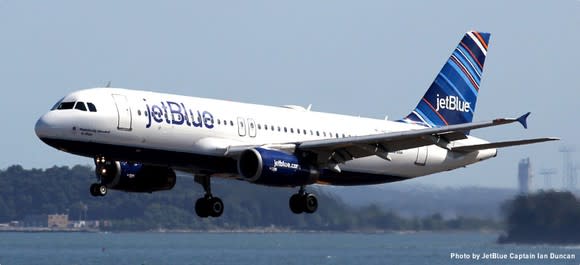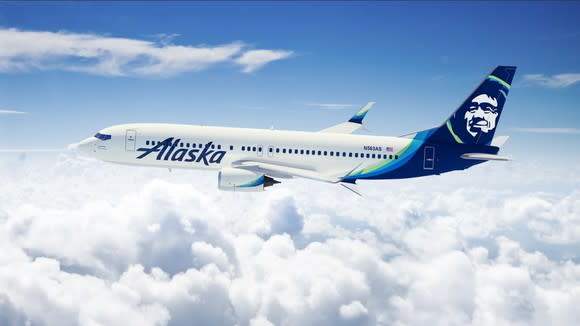JetBlue's Service Quality Is Improving Dramatically
Back in January, The Wall Street Journal (subscription required) revealed that JetBlue Airways (NASDAQ: JBLU) ranked last in its annual scorecard of the best and worst U.S. airlines for 2017. In 2015 and 2016, JetBlue had been a solid middle-of-the-pack performer, but terrible results in every category related to delays and cancellations doomed it last year.
This made JetBlue's showing in the 2018 edition of the Airline Quality Rating report all the more shocking. Despite its flight delay woes, the carrier marginally improved its score year over year and placed third overall among the top 12 U.S. airlines -- up from fourth a year earlier.

JetBlue took the No. 3 spot in this year's Airline Quality Rating report. Image source: JetBlue Airways.
JetBlue's surprisingly good score was driven by substantial improvements in its performance during the second half of 2017: particularly in November and December. This puts the carrier in good shape as it tries to move further up the rankings this year.
Summing up JetBlue's scorecard
The annual Airline Quality Rating study attempts to measure the quality of airlines' operations as objectively as possible. Airlines are scored on four criteria: 1) on-time performance; 2) the rate of involuntary denied boardings (i.e. passengers getting "bumped" from a flight); 3) the percentage of checked bags that are lost or arrive late; and 4) the rate of official complaints by passengers to the U.S. Department of Transportation.
In the 2018 report, Alaska Airlines -- a unit of Alaska Air (NYSE: ALK) -- came in first for the second consecutive year. Meanwhile, Delta Air Lines (NYSE: DAL) came up just short of the No. 1 ranking again, although it would have reached first place if the researchers had treated Alaska Airlines and its merger partner Virgin America as a single airline.
JetBlue reached third place primarily due to its enviable baggage-handling performance. It was No. 2 in the industry on that dimension, making up for its poor on-time performance. JetBlue's complaint rate was somewhat better than the industry average, while its rate of involuntary denied boardings was somewhat worse.

Alaska Airlines was the top-ranked airline in the 2018 Airline Quality Rating study. Image source: Alaska Airlines.
External events and execution issues created a perfect storm
JetBlue faced a series of challenges in 2017. First, it had to deal with runway closures at its two largest bases: New York's JFK Airport and Boston's Logan Airport. Both airports are heavily congested during the best of times. The runway closures caused delays to spiral out of control, hurting JetBlue disproportionately. (To be fair, JetBlue also contributed to its problems by not building enough cushion into its flight schedules, something it has fixed for 2018.)
At JFK, one runway was closed from late February through early June and then from September to mid-November. There was also nighttime work over the summer. As a result, the number of air traffic control delays roughly doubled. In Boston, a major runway was closed from mid-May until late June, with additional work continuing until November.
Second, JetBlue's big presence in Florida and its position as the No. 1 airline in the Caribbean meant that it was hit hard by Hurricanes Irma and Maria in September. These storms caused thousands of flight cancellations and even more delays.
The net result was that JetBlue's on-time arrival rate averaged just 66% from May to September, trailing the industry average by more than 12-percentage points.
Third, JetBlue entered 2017 without enough spare aircraft. Early in the year, maintenance issues sometimes forced it to substitute 150-seat A320s for 200-seat A321s. As a result, JetBlue "bumped" passengers at a higher rate than any other airline in the first quarter of 2017 -- even though it never overbooks its flights!
JetBlue has made huge strides
By mid-November, JetBlue no longer had to cope with runway closures at its top two airports. It had also taken several steps to improve reliability, such as reducing aircraft utilization, padding its schedules with extra time where necessary, and implementing new procedures for boarding and cleaning its aircraft.
This drove a remarkable turnaround in its performance. JetBlue's on-time arrival rate was within 2-percentage points of the industry average in November and just 6-percentage points behind in December. Involuntary denied boardings plunged from 1,415 in the first quarter to just three in the fourth quarter. Not surprisingly, this also reduced customer complaints compared to the rest of the year.
As a result, JetBlue posted the best quality score in the industry in December and trailed only Delta in November.
This doesn't necessarily mean that JetBlue will overtake Alaska Airlines and Delta Air Lines in next year's Airline Quality Rating report. Indeed, JetBlue has started 2018 with another uptick in flight delays and cancellations due to a series of severe winter storms that hit the Northeast. Yet the carrier has shown that over the course of a normal year, it can hold its own with the best in the industry in terms of overall service quality. That's of critical importance because Alaska and Delta are two of JetBlue's biggest competitors and will use any advantage to steal its customers.
More From The Motley Fool
Adam Levine-Weinberg owns shares of Alaska Air Group, Delta Air Lines, and JetBlue Airways and is long January 2019 $10 calls on JetBlue Airways. The Motley Fool recommends JetBlue Airways. The Motley Fool has a disclosure policy.

 Yahoo Finance
Yahoo Finance 